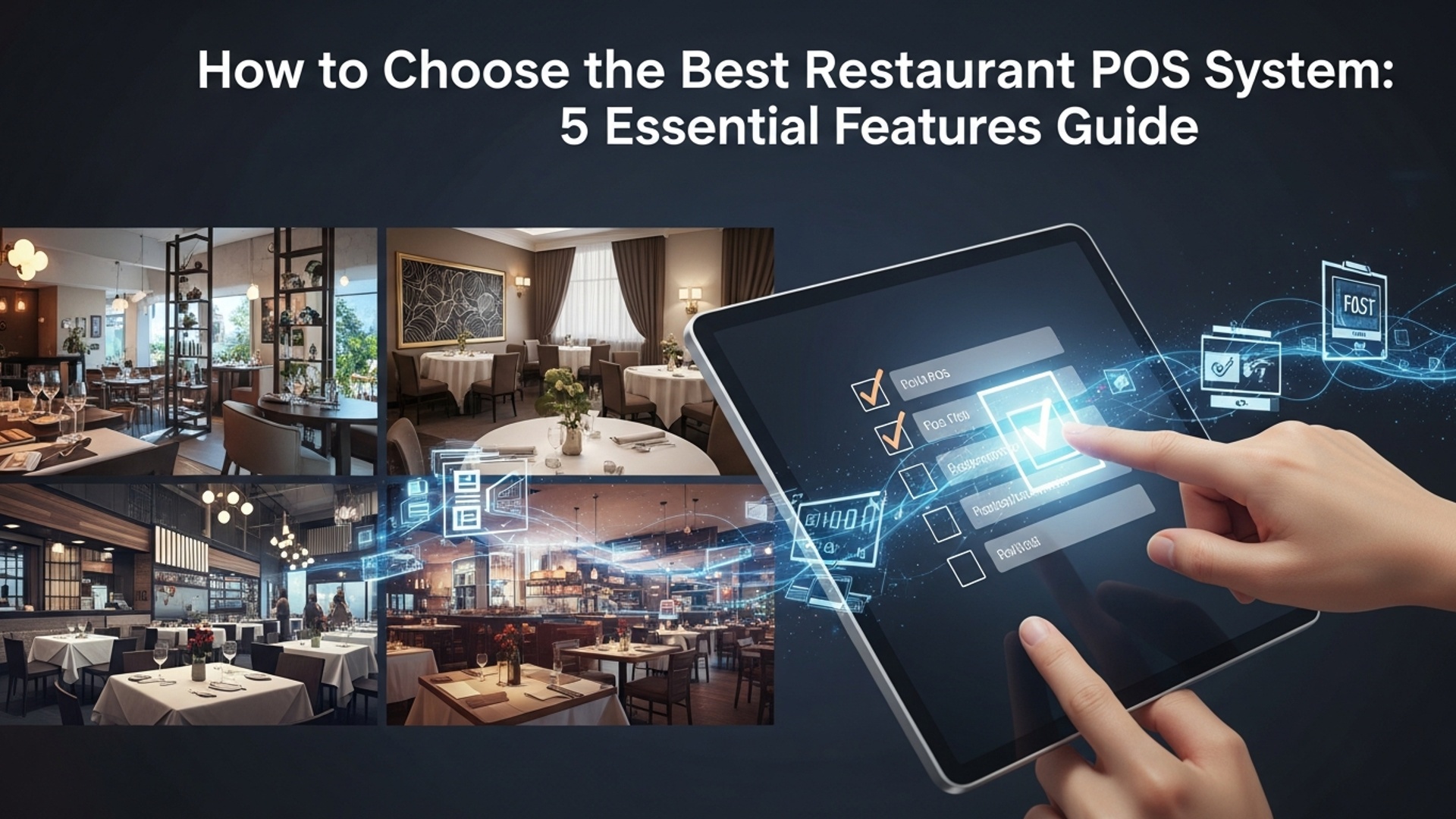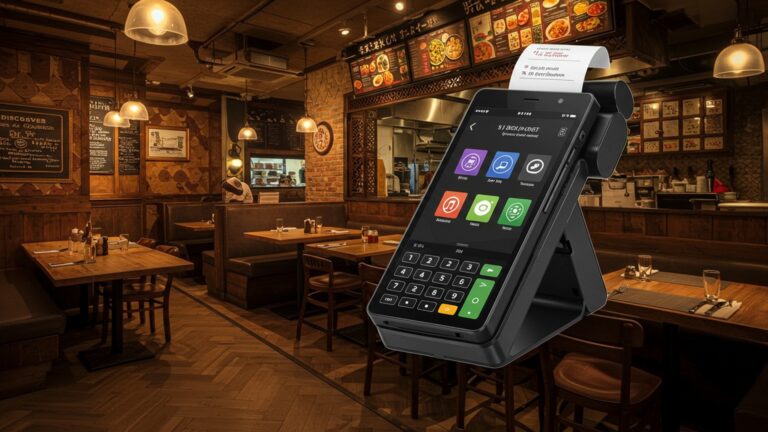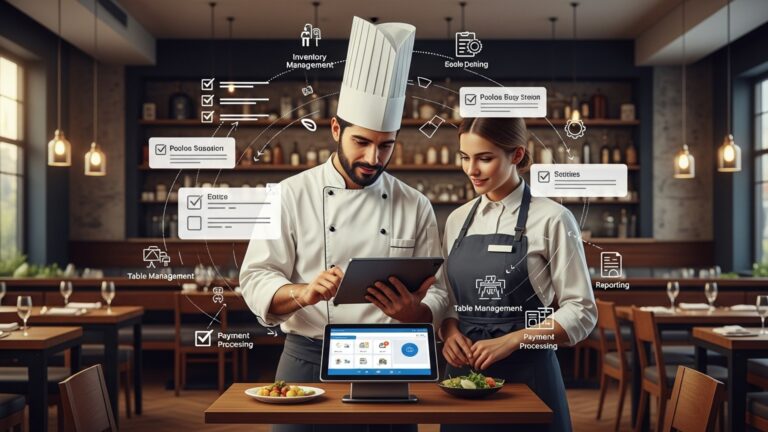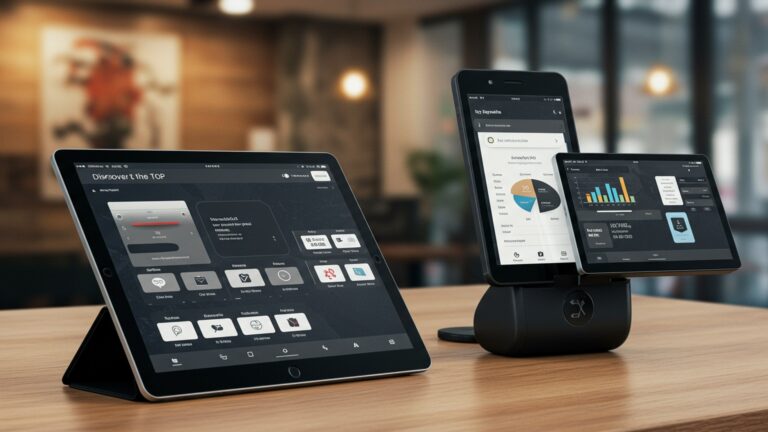How to Choose the Best Restaurant POS System 5 Essential Features Guide
In today’s hyper-competitive culinary landscape, robust Restaurant POS software transcends mere transaction processing, serving as the critical digital nerve center for modern operations. Savvy restaurateurs recognize that an advanced system now seamlessly integrates online ordering platforms, manages dynamic inventory in real-time. facilitates secure contactless payments, all crucial for maximizing profitability and efficiency. Beyond the front-of-house, a superior POS empowers kitchen staff, optimizes table management. personalizes the guest experience through integrated loyalty programs. Without a system capable of delivering real-time sales analytics and adapting to innovations like AI-driven menu recommendations or QR code ordering, restaurants risk significant operational bottlenecks and falling behind competitors leveraging cutting-edge technology to thrive.

Seamless Sales & Order Management
At the heart of any successful restaurant operation is its ability to efficiently manage sales and orders. This isn’t just about ringing up purchases; it’s the central nervous system that orchestrates everything from the moment a customer places an order to when they receive their bill. A robust Restaurant POS software excels here by streamlining the entire order-taking and payment process, directly impacting speed, accuracy. customer satisfaction.
- Intuitive Order Taking
- Table Management
- Diverse Payment Processing
- Online Ordering & Delivery Integration
The system should allow staff to quickly and accurately input orders, including modifiers (e. g. , “no onions,” “extra cheese”), special requests. split checks. For a busy Saturday night, imagine a server effortlessly customizing a large table’s order without a single error – that’s the power of good design.
Visual floor plans that enable hosts and servers to see table status (occupied, vacant, waiting for food) at a glance, assign servers. manage reservations. This feature prevents bottlenecks and enhances the dining experience by ensuring smooth table turnover.
Support for various payment methods is non-negotiable. This includes traditional credit/debit cards (EMV chip readers), contactless payments (NFC like Apple Pay, Google Pay), gift cards. even future payment technologies. Offline processing capabilities are also crucial, ensuring transactions can continue even if internet connectivity is temporarily lost, preventing lost sales.
In today’s digital age, seamless integration with your website’s online ordering system and third-party delivery platforms (like Uber Eats, DoorDash, Grubhub) is vital. This consolidates all orders into one system, reducing manual entry errors and operational complexity.
Consider “The Daily Grind,” a popular coffee shop that recently upgraded its Restaurant POS software. Their new system features a lightning-fast touchscreen interface. Baristas can take complex orders with multiple modifiers in seconds, reducing queue times significantly during peak hours. Moreover, its integrated online ordering module means customers placing orders for pickup through their website feed directly into the kitchen display system, eliminating the need for staff to monitor a separate tablet for online orders. This singular change led to a 15% increase in order accuracy and a noticeable improvement in customer flow.
When evaluating a Restaurant POS software, pay close attention to its user interface (UI) and user experience (UX). Ask for a demo and have your staff try it out. Is it logical? Can new hires learn it quickly? Does it support all the specific order-taking nuances of your menu, such as combo meals or complex modifiers? Ensure it handles split payments and tips easily, as these are common friction points.
Robust Inventory Management
Managing inventory effectively is paramount to a restaurant’s profitability, yet it’s often one of the most overlooked or poorly executed aspects. A robust inventory management module within your Restaurant POS software helps control costs, minimize waste, prevent stockouts. even inform your menu engineering decisions.
- Ingredient-Level Tracking
- Real-time Stock Updates
- Vendor Management & Purchase Orders
- Waste Tracking
- Alerts & Reorder Points
Beyond simply knowing how many bottles of wine you have, a sophisticated system tracks ingredients at a granular level. For example, when a burger is sold, the system should deduct the patty, bun, cheese slice. a specific amount of lettuce, tomato. sauce from your stock. This is often referred to as “recipe management.”
Every sale should automatically update inventory levels. This real-time data allows managers to see exactly what’s in stock at any given moment, rather than relying on outdated manual counts.
The system should allow you to manage supplier details, create purchase orders (POs). track incoming deliveries against those orders. This streamlines the procurement process and helps ensure you’re getting what you paid for.
The ability to log spoilage, spilled items, or discarded food. This data is critical for identifying areas of waste, adjusting ordering. refining kitchen processes.
Automatic alerts when stock levels hit a predefined reorder point. This prevents unexpected stockouts of popular items, which can frustrate customers and lead to lost sales.
Consider “Mama Mia’s Pizzeria.” Before implementing a Restaurant POS software with strong inventory features, they struggled with inconsistent ingredient levels, leading to last-minute runs to the grocery store or, worse, running out of popular toppings during peak hours. Their new POS system allowed them to input recipes for every pizza, tracking cheese, pepperoni. even dough balls. Now, when their mozzarella stock drops below a set threshold, the system automatically notifies the kitchen manager to place an order. Moreover, by tracking waste, they discovered that a significant amount of dough was being over-prepared and discarded, allowing them to adjust their daily production schedule and save hundreds of dollars a month.
When evaluating inventory features, ask about the level of detail the system can handle. Can it manage multiple units of measure (e. g. , buying flour by the bag, using it by the gram)? Does it integrate with scale systems for precise weighing? How intuitive is the process for conducting inventory counts and reconciling discrepancies? A powerful Restaurant POS software will save you money by minimizing waste and optimizing purchasing.
Integrated Customer Relationship Management (CRM) & Loyalty Programs
In today’s competitive restaurant landscape, customer loyalty is gold. An integrated CRM and loyalty program within your Restaurant POS software helps you interpret your customers better, reward their patronage. encourage repeat business. It transforms anonymous transactions into valuable relationships.
- Customer Profiles
- Loyalty Programs
- Gift Card Management
- Targeted Marketing Capabilities
- Feedback Collection
The ability to capture and store customer data (name, email, phone, birthday, dietary preferences) directly at the point of sale. This data forms the foundation for personalized marketing efforts.
Customizable programs that reward customers for their purchases. This could be a points-based system (e. g. , “earn 1 point for every dollar spent, redeem 100 points for a free appetizer”), tiered rewards, or visit-based incentives (“buy 9 coffees, get the 10th free”).
Seamless creation, sale, redemption. tracking of physical and digital gift cards. This is a powerful tool for attracting new customers and locking in future revenue.
Using the collected customer data to send personalized promotions, birthday offers, or announcements about new menu items. For instance, if a customer frequently orders vegetarian dishes, you could send them an email about your new plant-based menu options.
Some systems include tools for gathering customer feedback directly after a visit, allowing you to address issues quickly and improve service.
Consider “The Bistro,” a fine-dining establishment. Their Restaurant POS software includes a sophisticated CRM. When regulars dine, their server can see their past order preferences, favorite wines. even special dietary needs. This allows for truly personalized service, such as recommending a new dish based on their past choices or ensuring their allergy details is relayed to the kitchen without needing to ask again. Their loyalty program, which offers exclusive tasting menus for high-spending patrons, has created a sense of community and significantly boosted repeat visits. The Bistro saw a 20% increase in repeat customer frequency within six months of fully leveraging these CRM features.
When exploring Restaurant POS software, ask how easy it is to enroll customers in loyalty programs and capture their data. Does it integrate with email marketing platforms? Can you segment customers based on spending habits or visit frequency? A good CRM isn’t just about collecting data; it’s about making that data actionable to foster stronger customer relationships and drive sales.
Comprehensive Reporting & Analytics
Running a restaurant without robust reporting and analytics is like driving blindfolded. Data is the fuel for informed decision-making. a powerful Restaurant POS software provides the engine to process that data into actionable insights. This feature helps you comprehend your business performance, identify trends, optimize operations. ultimately boost profitability.
- Sales Reports
- Labor Reports
- Inventory & Cost of Goods Sold (COGS) Reports
- Customer Reports
- Menu Item Performance
- Customizable Dashboards
Detailed breakdowns of sales by hour, day, week, month, item, category, server. payment type. This helps identify peak hours, best-selling items. top-performing staff.
Track employee hours, wages, tips. labor costs as a percentage of sales. This is crucial for optimizing staffing levels and managing payroll efficiently.
Insights into your most expensive ingredients, food waste. the actual cost of items sold. This allows for accurate menu pricing and identifies areas where waste can be reduced.
Data on customer spending habits, visit frequency. the effectiveness of loyalty programs.
Identify which dishes are popular and profitable. which are slow-moving or costly, informing menu engineering decisions.
The ability to create personalized dashboards that display the most critical metrics at a glance, allowing managers to quickly assess the health of the business.
Take “The Urban Spoon,” a trendy restaurant that used its Restaurant POS software’s analytics to transform its operations. By analyzing hourly sales reports, they discovered a significant dip in sales between 2 PM and 4 PM. This data prompted them to introduce a “happy hour” menu with discounted appetizers and drinks during that specific window, successfully increasing revenue during what was previously a slow period. Their menu item performance reports also showed that a particular gourmet burger, while popular, had a very low-profit margin due to high ingredient costs. They adjusted the recipe slightly and increased the price by a dollar, significantly improving its profitability without impacting sales volume. This kind of data-driven decision-making is invaluable.
When evaluating Restaurant POS software, look for systems that offer both predefined and customizable reports. Can you easily export data for further analysis? Is the data presented in an easy-to-grasp format (e. g. , graphs, charts)? Real-time reporting is a huge advantage, allowing you to make immediate adjustments. Don’t underestimate the power of accessible data; it’s your compass for navigating the complexities of restaurant management.
Seamless Third-Party Integrations & API Access
No single piece of software can do everything perfectly. That’s why the ability of your Restaurant POS software to integrate seamlessly with other specialized tools is absolutely critical. Integrations allow different software systems to “talk” to each other, sharing data and functionality, creating a unified ecosystem that streamlines operations, reduces manual data entry. expands capabilities.
- Accounting Software Integration
- Online Ordering & Delivery Aggregators
- Employee Scheduling & Payroll
- Marketing & Email Platforms
- Open API (Application Programming Interface)
Connecting your POS with accounting platforms like QuickBooks or Xero automates the transfer of sales data, labor costs. inventory values, simplifying bookkeeping and ensuring financial accuracy. This saves countless hours for management and accountants.
Beyond basic order acceptance, deep integration with platforms like DoorDash, Uber Eats. your own online ordering system means orders flow directly into your kitchen display system, prices are automatically synced. inventory is updated without manual intervention.
Integration with platforms like When I Work or Homebase allows labor costs to be accurately tracked against sales, schedules to be managed efficiently. payroll processed without duplicate data entry.
Connecting with tools like Mailchimp or Constant Contact allows you to leverage customer data from your POS for targeted email campaigns, automated birthday greetings. promotions.
This is a more technical feature, indicating that the Restaurant POS software provides developers with tools and protocols to build custom integrations or connect with niche applications not natively supported. An open API signals flexibility and future-proofing.
Consider “Fusion Flavors,” a restaurant that prides itself on efficiency. Their Restaurant POS software integrates with their online ordering platform, allowing customers to order ahead for pickup or delivery. These orders flow directly to the kitchen. When the day ends, sales data automatically syncs with QuickBooks for accounting. Their employee scheduling software is also integrated, meaning employee hours are pulled directly from clock-in/out data in the POS, streamlining payroll. This web of interconnected systems drastically reduces administrative overhead. Their owner, Maria, estimates these integrations save her team over 15 hours of manual data entry and reconciliation each week, allowing them to focus more on customer service and menu development.
Before committing to a Restaurant POS software, create a list of all existing software and services your restaurant uses (accounting, payroll, online ordering, loyalty apps). Then, ask potential POS providers about their native integrations with these specific platforms. If a native integration isn’t available, inquire about their API. An open API offers the flexibility to custom-build connections down the line if needed. Choosing a system with strong integration capabilities ensures your entire business ecosystem works harmoniously, saving time, reducing errors. enabling scalability.
Conclusion
Choosing the ideal restaurant POS system transcends merely ticking off five essential features; it’s about architecting a seamless operational backbone that adapts and thrives. My personal tip is to view your POS as a living investment, not just a static tool. Consider its scalability and how it embraces emerging trends, like advanced inventory management for ingredient tracking or integrated online ordering platforms that reflect today’s digital-first diners. I’ve personally seen how a robust, cloud-based system can transform a bustling bistro from chaos to controlled efficiency, offering real-time data insights that were previously unimaginable. Don’t settle for “good enough.” Take the actionable step of scheduling a personalized demo, focusing on how the system tackles your unique challenges, from table management during peak hours to streamlining employee scheduling. This diligent selection process, leveraging the knowledge of these essential features, will empower your staff, delight your customers. ultimately drive your business forward. Embrace this decision with confidence; your restaurant’s future success depends on it. For deeper insights into industry shifts, explore resources like Restaurant Tech Trends.
More Articles
How to Choose Key Restaurant POS System Features for Seamless Operations
Learn 7 Smart Restaurant POS Features to Boost Your Business Profits
5 Key Strategies How to Choose the Best Restaurant POS System
Discover 7 Essential Benefits of Modern Restaurant POS Software Solutions
Tutorial 10 Best Practices for Smooth Restaurant POS System Implementation
FAQs
What’s the absolute most vital thing a restaurant POS system needs to do?
A top-notch POS system absolutely must excel at handling orders efficiently, processing various payment types smoothly. managing your tables. These are the foundational elements that keep your restaurant running day-to-day without a hitch.
How crucial is inventory management in a POS system for a restaurant?
It’s super vital! A good POS system should help you track ingredients and dishes, manage stock levels in real-time. even flag when you’re running low. This prevents waste, helps control food costs. ensures you never unexpectedly run out of popular menu items.
Can a POS system actually help me grasp my business better?
Absolutely! The best systems offer robust reporting and analytics. You can pull data on sales trends, peak hours, popular dishes, staff performance. more. This insights is invaluable for making smart business decisions, optimizing your menu. improving overall efficiency.
What about keeping customers coming back? Can a POS help with loyalty programs?
Definitely. Many modern POS systems include built-in CRM features or integrate seamlessly with loyalty programs. This lets you track customer preferences, offer personalized promotions. manage loyalty points, which is fantastic for building repeat business and strong customer relationships.
My staff isn’t super tech-savvy. How essential is it for a POS to be easy to use?
It’s incredibly vital! An intuitive and user-friendly interface means your staff can learn it quickly, make fewer mistakes. serve customers faster. A complex system can slow down service and frustrate both employees and customers. Always look for something that’s straightforward to navigate and train on.
Should my POS system be able to talk to other software I use, like for online orders or accounting?
Yes, absolutely! Modern restaurants often use various tools. A good POS system should integrate seamlessly with things like online ordering platforms, third-party delivery services, accounting software. even employee scheduling tools. This creates a unified system, reduces manual data entry. streamlines operations across the board.
What kind of support should I expect from a POS provider in case something goes wrong?
Excellent customer support is non-negotiable. You need a provider that offers reliable, prompt assistance, ideally 24/7, given how critical a POS is to your operations. Look for providers with good reputations for technical support, troubleshooting. quick problem resolution to minimize any potential downtime.





